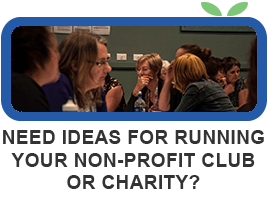Last updated April 11, 2016
Over the last few years it has become obvious that small organisations need to work more collaboratively if they want to survive in the changing marketplace. There is constant chatter about collaboration rather than competition, and even the government is focussed on service delivery across portfolios, rather than in silo situations.
But while the motivation for working together may have been caused by the economic downturn, organisations who are working collaboratively have noticed far greater benefits than simple finances. In all the work we do around the country, it’s clear that the communities which have a strong non-profit sector are the communities where organisations are not afraid to work together.
By sharing skills, expertise and resources, these organisations are building a collective strength that they simply could not do as individual entities. They are living out the age-old principle that ‘the whole is always greater than the sum of individual parts.’
So while it’s clear that increased collaboration is a positive and necessary move for the sector, some organisations are still worried that collaboration will mean loss of control and loss of identity. Take a breath! Collaboration doesn’t necessarily mean mergers and acquisitions; it simply means you agree to work more closely with others so that both parties can better achieve their goals. And given that we are all looking for community outcomes, it’s useful to remember the words of Harry Truman:
“It’s amazing what you can achieve when you don’t care who gets the credit.”
1. Get Read
Pair up with an organisation that shares a similar client or member demographic and make use of each other’s newsletters. It could be that you each write an article for publication, or perhaps you have an agreed upon space to promote your upcoming programmes and fundraising events. You’ll both be reaching people you wouldn’t ordinarily have contact with, and you have the benefit of being related to an organisation the readers already know and trust.
2. Get Seen
Gather together with 7 or 8 organisations that work in the same field as you, and commit to taking a full-page advertisement in your local newspaper each month. Because you are committing to a regular space you will be able to negotiate a much better rate, plus the cost of advertising will be split between all the groups involved.
Design a set format so that every organisation has a presence in the advertisement, with a different organisation being featured with an editorial each month. By working together you will create a larger collective presence and with repetition, comes reputation.
3. Get Linked
Set up reciprocal website links with other community organisations in your region. If you had every organisation on board, you would create a multitude of community service directories which promote the entire sector. No matter where potential clients or members started looking, they would find the service or programme that best meets their needs.
4. Get Social
It’s easy to work collaboratively using Social Media, and as a result everybody leaves a much bigger online footprint. Simply make a point of liking, commenting and sharing the posts of other organisations. Your followers will get to see what’s going on with other groups, and their followers will be introduced to you and your cause.
5. Get Vocal
Work together with like-minded organisations to build an awareness campaign for a common cause. The White Ribbon campaign is a great example of how this can work and it can happen just the same regardless of what sector you’re in.
Start by thinking about other organisations in your sector and then consider the common denominator that ties you all together. What is the one issue you would all like to bring in to the public arena? When you raise awareness of a common plight, you also raise awareness of your individual work and how important it is in the community.
6. Get Busy
Organising a fundraising event can be hard work, especially if you are a small organisation with limited volunteers. An easy way to collaborate with others is to organise a joint fundraising event or activity. By joining together you get twice as many people helping out, and twice as many people to market your event to. Through collaboration you are more likely to create an event of significance and instead of fighting for your piece of the fundraising pie, you can work together to make the whole pie bigger.
7. Get Trained
No matter what organisation you’re in it’s likely that there are some core training needs that you share with other non-profits. Next time you organise a training day around those core issues, why not invite people from other organisations to attend as well?
Perhaps your organisation is particularly good at Volunteer Management and could organise some training around that. Another organisation in your area might be particularly good at Marketing and Communication, and so on. For more specialised training you could hire an outside facilitator and have several groups share the cost.
8. Get Volunteers
Recruiting and retaining volunteers is a full-time job for most organisations, and if you’re a small organisation it’s sometimes difficult to get all the volunteer help you need. Why not team up with another organisation and agree to ‘Volunteer Exchanges’ for specific projects or one-off events. Alternatively you could provide a ‘Volunteer Exchange’ for specialist skills.
9. Get Networked
Create a regular networking group where the focus is on developing new skills and expertise. Each meeting participants bring along a new idea, tool or tip to share with the rest of the group and everyone learns from the shared wisdom.
10. Get a Place
Sharing facilities with a group of other organisations is becoming more and more popular, but the concept of ‘hubs’ or ‘community houses’ has been around for many years. No two models are exactly the same, but one that has worked very successfully is where several groups occupy one building and have a range of shared facilities such as meeting rooms, workshop spaces, a staff room and reception. Each organisation has their own offices and one group takes the lead in tying everything together.
If you don’t have a Community House or a Community Hub in your area, you can still look at sharing facilities with other organisations on a smaller scale. Someone just has to start the conversation.
11. Get a Satellite
If you are looking to expand your services into another region but can’t justify the extra office space for the limited hours you will be there, talk to another organisation about a ‘Satellite Office’ exchange. You use some of their office space to deliver your services on one or two days a week, and then they use some of your office space to do the same in return.
12. Get Discounts
It’s no secret that the more you buy, the more purchasing power you have when it comes to negotiating discounts. Talk to local suppliers and local organisations about developing a ‘Joint Buying Group’. Instead of negotiating discounts based on the purchasing power of one small organisation, suppliers can consider the collective purchasing power of the whole group.
13. Get Equipment
Most organisations have one or two pieces of equipment that are only used on an infrequent basis. It might be presentation equipment such as data projectors or whiteboards, it might be event equipment like gazebos or loud hailers, or it could be specialist items for programme delivery.
Talk to other organisations about what equipment they have on hand and create a list of available resources in your area. By encouraging organisations to share the equipment across the sector, you are putting less pressure on funders and ultimately making more funds available for the things that really matter. You may well need to operate a bond system or even a small hire fee, but by pooling equipment you can make sure that resources are being used to their full capacity.
14. Get Heard
If something is happening with local or central government that affects your organisation, chances are it affects other organisations as well. Work together to write combined submissions, or simply share your submission with other organisations so that they can use your points as a template to get started.
15. Get Data
If you are doing any sort of community related research, make it available for other organisations to benefit from. You can upload your research to communityresearch.org.nz and of course while you’re there, you can share in other people’s research as well.
16. Get Connected
When putting together your various programmes consider what services are already being offered by groups in your area and think about how they could be tied together. A visiting service could act as a distributor for food parcels, a holiday programme could link up with a local arts organisation and so on. Before you create something new, think about how you can use what already exists.
The more we practice collaboration, the stronger the whole sector will become. Collaboration is not about losing identity or stifling diversity; it’s about looking for the cross-over points and making a conscious effort to do those bits together.
If you think this article would be useful for your members, you are welcome to use it on your website or in your newsletter. We just ask that you let us know where it is being used, and that you acknowledge our website at the bottom of the article. If you are using the article online, please include a link to our homepage.




